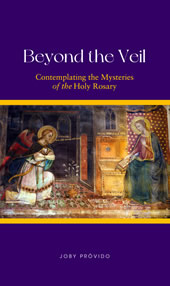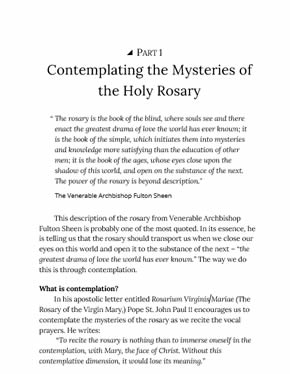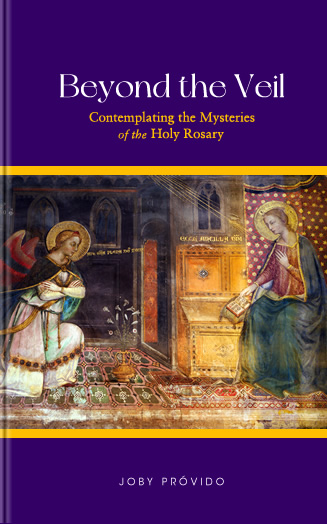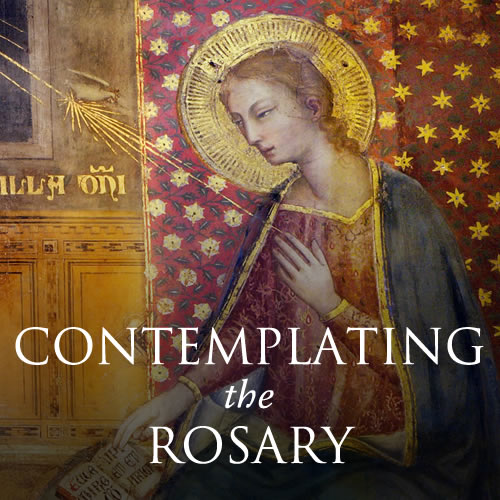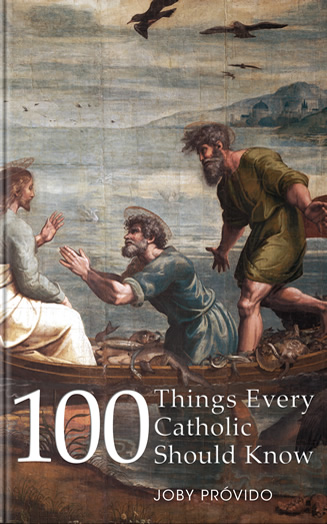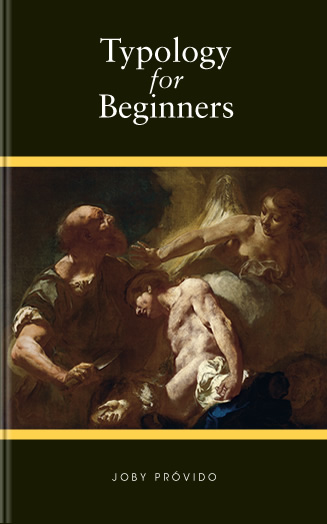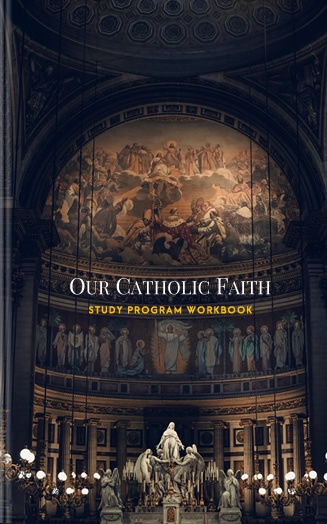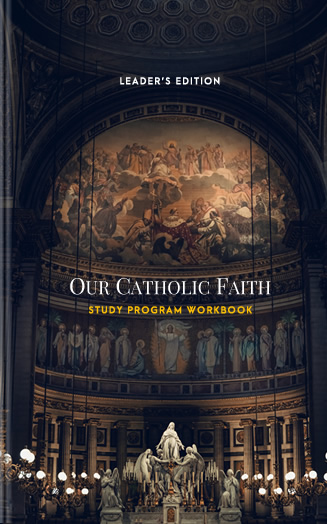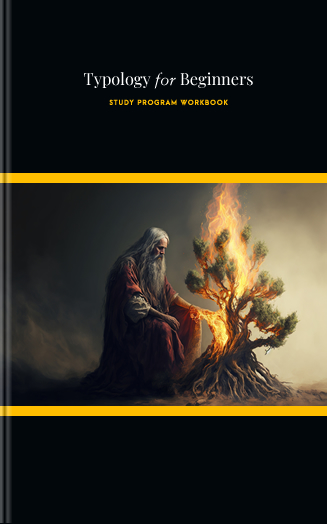Saint Pope John Paul II encourages us to meditate on the mysteries of the Holy Rosary in his apostolic letter entittled Rosarium Virginis Mariae. Sadly there is no book that remotely teaches this method. Beyond the Veil comes to the rescue by providing seven concrete steps on how to do this. The book also explores the mental images of each mystery with meticulous detail.
Let us revive our love for this cherished Catholic devotion by learning to contemplate the mysteries. By doing so, each rosary will be fresh, new, meaningful, and so exciting that we will look forward to our next one.
THE BOOK
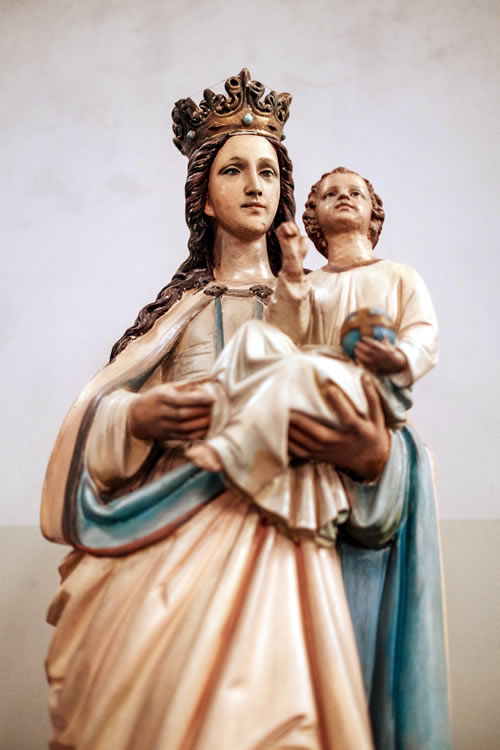

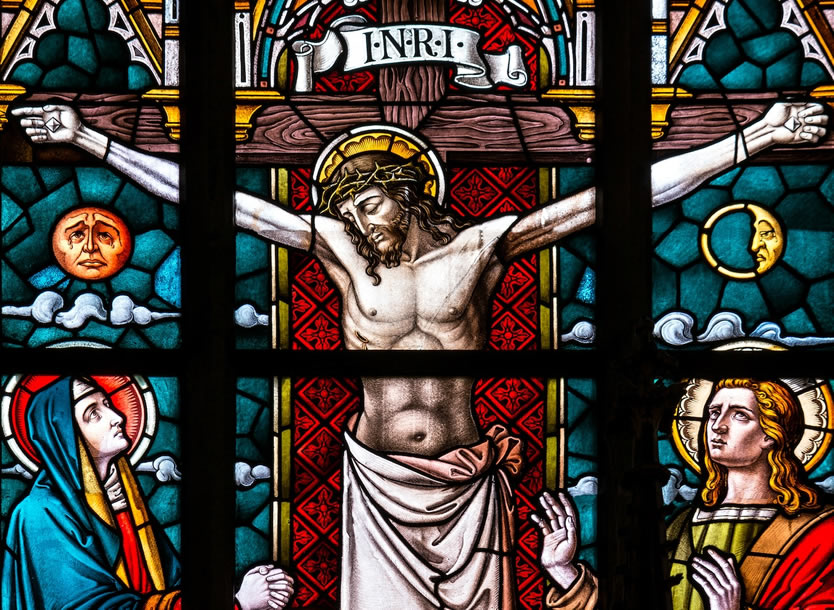

Learn to contemplate each mystery of the Rosary and meet Christ in each one of them
We've learned to pray the rosary by concentrating on the words of the vocal prayers. Some might even think it scandalous not to do so. But prayer giants like Pope St. John Paul II, Pope Paul VI, Archbishop Fulton Sheen, and Bishop Robert Barron recommend thinking of the mysteries as we pray. But how can that be?
The trick is to let your lips do automatically what it has been doing for years when you pray the rosary. This gives your mind the freedom to explore the images connected with the different mysteries.
Beyond the Veil will help you in this process by suggesting seven important steps to get you contemplating on the mysteries.
A problem one might face in praying this way is the lack of mental images. So a large part of the book explores each of the mysteries and provides context and visual mental references that you can recall while praying the rosary. It even suggests specific mental images for each bead.
Pray the rosary the way it is supposed to be prayed: contemplate on the mysteries.
READ THE WAY YOU WANT
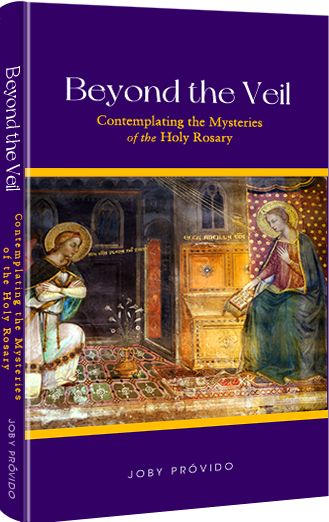
| Paperback | |
|---|---|
| ISBN 13 | 979 855 42 0322 0 |
| ASIN | B0BQLW26QF |
| Publisher | Kindlings Press |
| Publication Date | December 9, 2022 |
| Language | English (American) |
| Size | 6" x 9" |
| Pages | 361 cream |
| Cover | Full color, matte-finished |
| BUY ON AMAZON | |

| Hardbound | ||
|---|---|---|
| ISBN 13 | 979 837 04 6643 4 | |
| ASIN | B0BQMPHHYH | |
| Publisher | Kindlings Press | |
| Publication Date | December 9, 2022 | |
| Language | English (American) | |
| Size | 6" x 9" | |
| Pages | 361 cream | |
| Cover | Full color, matte-finished | |
| BUY ON AMAZON | ||

| Kindle Ebook by Amazon | |
|---|---|
| File Size | 1807 KB |
| ASIN | B0BQL6M34Q |
| Publisher | Kindlings Press |
| Publication Date | December 19, 2022 |
| Language | English (American) |
| Print Length | 403 pages |
| Text-to-Speech | Enabled |
| X-ray | Not Enabled |
| Word Wise | Enabled |
| Enhanced Typesetting | Enabled |
| Sticky Notes | On Kindle Scribe |
|
Download the free Kindle App and start reading today. |
|
| BUY ON AMAZON | |
Now an AUDIO BOOK you can listen to!
Listen as you drive, workout, or bask under the sun.EXCERPTS
What is contemplation?
In his apostolic letter entitled Rosarium Virginis Mariae (The Rosary of the Virgin Mary,) Pope St. John Paul II encourages us to contemplate the mysteries of the rosary as we recite the vocal prayers. He writes:
“To recite the rosary is nothing than to immerse oneself in the contemplation, with Mary, the face of Christ. Without this contemplative dimension, it would lose its meaning.”
Years before that, Pope Paul VI also urged the faithful to do the same thing when he wrote in his Apostolic Exhortation, Marialis Cultus (The Cult of Mary.) He wrote:
“Without contemplation, the rosary is a body without a soul, and its recitation runs the risk of becoming a mechanical repetition of formulas….”
For both popes to write on the same matter with the same message must have meant they had a burning desire to express the importance of contemplation, and if this is so, we must consider it.
So what is this contemplation they so desire us to do? There are three kinds of prayer forms. One is vocal prayer, where we use words, whether or not we recite them aloud or move our lips. Usually, we follow formula prayers like the Our Father, Hail Mary, or Glory Be. Spontaneous prayers are also vocal because we use words.
Another form of prayer is meditation, also called mental prayer. This is when we quest to discover what God wants of us through reading Sacred Scripture, listening to a spiritual talk, or immersing ourselves in music or art.
It is a mental type of prayer because we no longer use words to give attention to God. Christian meditation aims to find out what God wants us to do, so it should not be confused with Eastern meditation, whose goal is tranquility.
The third form of prayer is contemplation. There are two sub-types of this prayer mode. The first is regular contemplation, where we put ourselves in front of God – usually beholding the Blessed Sacrament – simply to bask in his presence. The other sub-type is infused contemplation. This is when God himself lifts us so we can gaze at him profoundly and spiritually. We cannot produce infused contemplation because it is a gift from God. We have no control over when or where it happens or how long it will last. The only thing we can do is accept it.
Clearly, from this definition, it is not infused contemplation we are being asked to do. Instead, from context, “contemplating the mysteries of the Holy Rosary” means to reflect on the mystery at hand while praying the vocal prayers, so we become present in that scene in Christ’s life.
This might come as a shock to most of us who have been taught to concentrate on every word that is being said in prayer. It might also seem odd to think about something while saying the rosary because praying vocally and reflecting on something else do not instinctively go together. We usually stop one to do the other. But saying the vocal prayers while meditating simultaneously is precisely what Popes Saint John Paul II and Paul VI advocate us to do. Venerable Archbishop Fulton Sheen has this to say about the rosary:
“It is a prayer that has a beautiful combination. I don’t think there is any prayer in the world that has the combination of the rosary. First of all, it is vocal: we say some prayers with..."
3
Put Christ in Each Scene and Gaze at his Face
Christ is in every mystery of the rosary
The Rosary, though clearly Marian in character, is at heart a Christocentric prayer. This means it is Christ who we are following, and it is Mary who leads us to gaze at the face of Christ, discover him in secret, and understand his message. We should, therefore, include Christ in every mystery.
There are some mysteries that one might think he is not there. These are The Annunciation, The Visitation, The Descent of the Holy Spirit, the Assumption, and the Coronation of Mary as Queen. But if we look deeper, he is in them too.
At The Annunciation, he is incarnated in the womb of Mary when she accepts God’s invitation when she says, “Behold I am the handmaid of the Lord, be it done to me according to your word.” Our liturgical calendar reflects this when we celebrate Christmas on December 25 and The Annunciation on March 25, which is exactly nine months before because it is the gestation time of a baby inside a womb. Incidentally, the feast of The Annunciation is also called the Feast of the Incarnation. So, in this mystery, we may imagine Christ in the womb of Mary. We can ponder, “What is he experiencing as a human?”
At The Visitation, Christ travels in his mother’s womb to the house of Zechariah on the hills of Judea. There Mary meets her cousin, Elizabeth, whom the Holy Spirit gifted with the knowledge that her visitor is the “mother of my Lord.” There, Mary, and Christ in her womb, attended to Elizabeth, most likely until John the Baptist was born.
At the Descent of the Holy Spirit, Mary was with the apostles when it was time for the Paraclete to be sent to them as representatives of the Church. Since the Holy Spirit is the Spirit of Christ, we may imagine Christ is with the Father when they send the Holy Spirit to them.
At The Assumption and The Coronation of Mary as Queen, how can we not imagine Christ there to receive his mother and crown her? When her body and soul were taken up to heaven, it would be absurd that no one would receive her there. And if there were persons there to do so, it would be doubly absurd if Christ was not one of them. The same thing goes for The Coronation. As we will see later, the reason why Mary is Queen is that her son is King. How nonsensical it would be for a Queen to be crowned without the King, who is the cause of her queenship.
With this as context, let us ensure Christ is in each mystery, for his is the face we want to “read.”
Gaze at Christ the way his mother did
When Jesus was born, Mary gazed tenderly at her son's face as she wrapped him in swaddling clothes and laid him in a manger. With that gaze, she was filled with so much adoration and wonder that she would never leave him – not even taking her eyes away from him until his death.
No one ever devoted themselves to the contemplation of the face of Christ as faithfully as Mary did. When she found Jesus in the temple, her way of contemplating him was to ask him, “Son, why have you done this to us?”
Her penetrating gaze can deeply understand Jesus to the point of perceiving his hidden feelings and anticipating his decisions, just like in the Wedding in Cana. We try to replicate this kind of gaze, so we know Christ with such intimacy.
Suggested points of view
- Through the eyes of Mary.
- Through the loving eyes of the Father looking at the spiritually- beautiful Woman he chose to become the mother of his only Son.
- Through the eyes of the Father, seeing his only Son take human form in the womb of the Woman he prepared from all eternity.
- Through the eyes of the Angel Gabriel.
- From above.
Full of grace
Whenever angels manifested themselves, fear gripped the people to whom they appeared. Zechariah certainly was troubled and fearful when Gabriel visited him. The angel must have been a sight so incredible that he appeared otherworldly and, therefore, frightening.
However, when the Angel Gabriel went to Mary, Scripture tells us that she was troubled by his greeting, not his appearance. When the Bible describes angels, they seem so formidable that they scare the onlooker. When an angel appeared to Daniel, he described it like this: “I saw a man dressed in linen with a belt of fine gold around his waist. His body was like chrysolite, his face shone like lightning, his eyes were like fiery torches, his arms and feet looked like burnished bronze, and the sound of his voice was like the roar of a multitude.” Daniel continued to say that the others with him were seized with fear and fled even if they had not seen the vision. After that, Daniel’s strength was drained, powerless, fell forward, and became unconscious.
If they were filled with dread and weakened from the angel’s manifestation, Mary did not fear and become weak at Gabriel’s presence. Maybe it was because her perfection by grace was far more magnificent than his was.
There are two parts of the angel's message that is the cause of Mary’s distress. The first is “Hail, full of grace.” This seemingly short and trite greeting should not be distressing at all – unless we break it down to its structure. Usually, the name or title of the person comes after “Hail.” Romans, for example, greeted their leader, “Hail, Ceasar!” In the later and darker years of World War II, the Nazi party greeted their Führer as “Heil, Hitler.” Therefore, when we apply this syntax to Gabriel’s greeting, it is as if “Full of Grace” is the name or title of Mary.
If this is so, we don’t think it was Gabriel who gave Mary a new name, but God himself. From Old Testament times, it was God who changed the names of people. He changed Abram to Abraham, Sarai to Sarah, and Jacob to Israel, to name a few. Since he is the creator, he reserves the right to change the names of people according to the role they are to play in his plan.
The second part of Gabriel’s greeting is, “The Lord is with you.” Mary, being a devout Jew, must have known this is a phrase uttered whenever God asked something from someone. For example, when an angel asked Gideon to lead God’s chosen people against the Midianites, the greeting was, “The Lord is with you, you mighty warrior!” Also, when Jeremiah prayed for counsel on what to do when Nebuchadnezzar captured Jerusalem, the Lord told him, “Do not fear the king of Babylon, as you do now. Do not fear him – oracle of the LORD – for I am with you to save you, to rescue you from his power.”
A Theophany
The next thing that happened, we are told, is that a voice came from the bright cloud that cast a shadow over them. The voice said the same thing during The Baptism in the River Jordan. “This is my beloved son.” But the voice said something new to the apostles. It said, “listen to him.”
We know this voice to be the voice of the Father, and the bright cloud, the presence of the Holy Spirit. From the account of St. Matthew, they were not too frightened by the cloud but terrified by the voice; they were too frightened that they fell prostrate. One tiny detail that St. Matthew tells us is that they “raised their eyes” when Jesus touched them. This would have meant that their eyes were on the ground the whole time. Their prostration and eyes tell us they were afraid but had the presence of mind to show reverence. This coming together of the three Persons of the Blessed Trinity is a theophany – a visible manifestation of God that is perceptible to humans. It was just proper that the apostles assumed a position of devotional worship.
The Father’s message is very short but profound. From the beginning of time, every human must have asked the same questions when thinking about life: why am I here? Where can happiness be found, and what is the meaning of my existence? The Father tells us that all of this can be found in one person – Christ.
“Listen to him,” the Father said. We listen to a person, and we listen to spoken words. In effect, the father is telling us that Jesus is his Divine Word. It dovetails nicely with how John describes Jesus: “In the beginning was the Word, and the Word was with God, and the Word was God. He was in the beginning with God. All things came to be through him, and without him nothing came to be. What came to be through him was life, and this life was the light of the human race.”
Jesus is the word, and he is the light – could the transfiguration be the inspiration for John to start his Gospel this way since all the elements are found in it?
If Jesus is the Word, the implications are tremendous. He is the Torah. He is Scripture, for isn’t it the word of God? The same John would write many years at Patmos, the Book of Revelation. There he relates a vision of a scroll no one can open. Only the Lion of Judah, who turns out to be a lamb as if slain, can unlock it. In symbolic terms, John explains that Christ is the key to understanding Scriptures. This is why “The redeemer of man, Jesus Christ, is the center of the universe and history.”
Suggested scenes to focus on each bead of this mystery:
- Jesus ascends Mount Tabor bringing along Peter, James, and John.
- They begin to pray, but the appearance of Jesus changes; his face becomes radiant, and his clothes become dazzling white.
- Moses and Elijah join Jesus. They speak of Christ’s “Exodus.”
- Thinking or hoping this “meeting” will last long, Peter suggests to Christ that the apostles there will put up tents.
- The apostles become frightened when a bright cloud descends and envelopes them.
- The apostles hear a voice that says, “This is my chosen Son; listen to him.”
- Frightened, the apostles prostrate themselves as a sign of total submission to God.
- With their faces to the ground in fear, Jesus touches them and says, “Rise, do not be afraid.”
Table of Contents
Preface
Introduction
PART 1 Contemplating the Mysteries of the Holy Rosary
An Approach to Contemplating While Praying Vocally
1. Put yourself in the scene
2. Journey with Mary through the scene
3. Put Christ in each scene and gaze at his face
4. Fill in what scripture does not explicitly tell us
5. Consider a different angle
6. Read the Gospels
7. Let God touch you
PART 2 Mental Images from the Mysteries of the Holy Rosary
The Joyful Mysteries
The Annunciation
The Visitation
The Nativity of Jesus
The Presentation in the Temple
The Finding of the Child Jesus in the Temple
The Luminous Mysteries
The Baptism of Jesus in the River Jordan
The Miracle in Cana
The Proclamation of the Kingdom of God
The Transfiguration
The Sorrowful Mysteries
The Agony in the Garden
The Scourging at the Pillar
The Crowning of Thorns
The Carrying of the Cross
The Crucifixion and Death of Our Lord, Jesus Christ
The Glorious Mysteries
The Resurrection
The Ascension
The Descent of the Holy Spirit
The Assumption of Mary into Heaven
The Coronation of Mary as Queen
PART 3 How to Pray the Rosary
Mysteries of the rosary
Using the beads
Prayers used in the rosary
Bibliography
Other books by the author
About the Author
HIGHLIGHTS
OTHER BOOKS
A Sky Full of Stars
Know Our Lady through her titles in the Litany
Get to know Mary as each of her titles in the Litany of the Blessed Virgin Mary is explained meticulously.
100 Things Every Catholic Should Know
Understand what it is Catholics believe in bite-size nuggets. Very easy to read and topics build on one another.
Typology for Beginners
A Catholic Perspective on Understanding the New Testament through the Old Testament
See the subtle patterns emerge as the New Testament is read in the context of the New Testament. Obscure verse become clear, and the Bible exciting again.
Our Catholic Faith - Workbook
For A Study Program
A deep dive into the Catholic Faith for study groups or individual use. The program uses a unique blend of Sacred Scripture and Tradition to help the participant explore what it is Catholics believe.
Our Catholic Faith - Leader Workbook
For A Study Program - Leader's Edition
Everything you need to run the Our Catholic Faith Study Program. This edition includes a setup guide, and answers to the guide questions.
Typology for Beginners - Workbook
For A Study Program
Unlock the hidden treasures of the Bible and dive into the world of typology to embark on a journey of discovery to how Old Testament types foreshadow Christ, Mary, Salvation, the Church, and the Sacraments.


